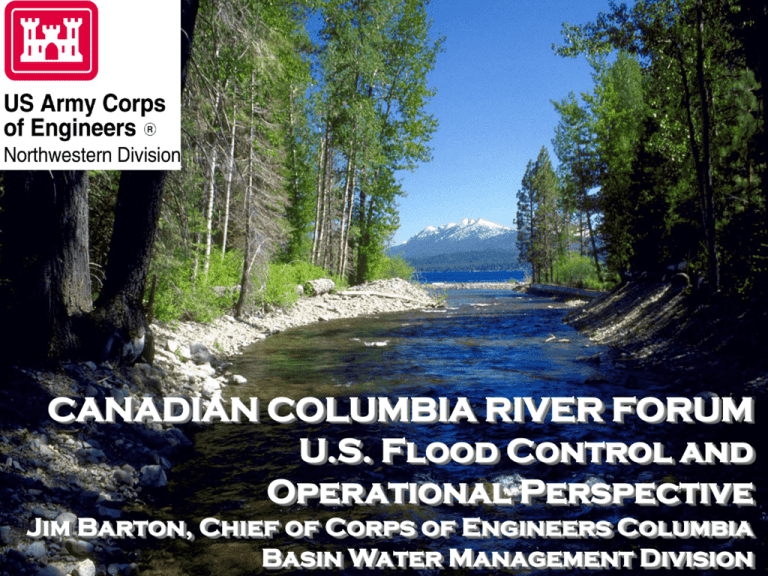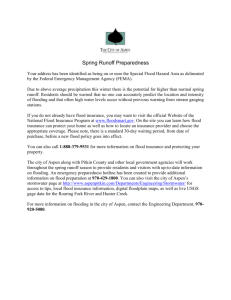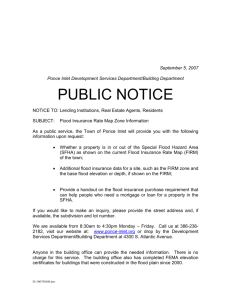U.S. Flood Control and Operational Perspective
advertisement

CANADIAN COLUMBIA RIVER FORUM U.S. Flood Control and Operational Perspective Jim Barton, Chief of Corps of Engineers Columbia Basin Water Management Division Outline • Background • Operations Management and Objectives • Current and Future Studies & Activities • Emerging Issues • Conclusions Background • Corps of Engineers has 35,000 employees organized into 8 Divisions, 40 Districts, Headquarters • Civil Works and Military Mission • Managing over 500 water projects nationwide • Columbia River projects managed from Northwestern Division office in Portland, Oregon • Corps is part of U.S. Entity with BPA for Treaty Project Operating Purposes Navigation 12000 miles of inland waterway 926 harbors 2.4 M tons of commerce/year 270 M cubic yards dredged/yr Hydropower 75 projects, 20720 MW capacity 3% of total US electric energy $700M in power sales to Treasury Flood Control 383 reservoirs 8500 miles of levees Prevent $6 in damage for every $1 invested Environmental Water storage for fish and wildlife Water quality management Wetlands and habitat Water Supply Recreation 153 projects supply cities Including Wash. DC area 4,340 sites at 456 projects 375 M visits/year $15 B to local economies MILLIONS OF ACRE FEET AVERAGE ANNUAL RUNOFF AND USABLE RESERVOIR STORAGE MAJOR WESTERN RIVER BASINS 250 240 230 220 210 200 190 180 170 160 150 140 130 120 110 100 90 80 70 60 50 40 30 20 10 0 Average Annual Runoff Usable Reservoir Storage Columbia Colorado RIVER BASINS Missouri Operations Management and Objectives • Corps coordinates closely with other parties in the region to achieve multi-purpose objectives • Flood control objectives are to maintain nondamaging levels, system-wide and in local areas • Reservoirs typically drafted by March-April period based on seasonal runoff volumes • Draft provides space to collect snowmelt runoff in April-July period, refill by about July • Cumulative flood damages prevented ~ $14 billion, $5 B damages prevented in 1996-97 Benefits of Federal Projects (Damages Prevented) Cumulative Corps Expenditures (Principle plus O&M) Adjusted to 2000 using Construction Cost Index $900 Flood Damage Reduction $700 BENEFITS TO COST $600 $6.35 in Benefits for every $1.00 Invested Cumulative Benefits $500 $400 $300 $200 Cumulative Expenditures $100 Annual Benefits Fiscal Year 2000 1996 1992 1988 1984 1980 1976 1972 1968 1964 1960 1956 1952 1948 1944 1940 1936 1932 $0 1928 Billions of Dollars $800 Current & Future Studies and Activities • System Flood Control Review: Investigate changes to flood control to benefit endangered species. • Variable and Shifted Flood Control: Implementing options to adjust flood control to meet other needs • Improved Forecasting Procedures: SOI, etc. Emerging Issues • Increasing system-wide demand for storage and flows for fish & wildlife and other purposes – Challenge to satisfy often competing uses – Increasing interest in modifying flood control and other operations in both countries – Increased development in floodplains may require more flood control, rather than less • Implications of potential climate change on operations and flood control • Aging water resources infrastructure and constrained budgets Climate Change: Changes in Simulated April 1 Snowpack for the Canadian and U.S. portions of the Columbia River Basin (% change relative to current climate) Current Climate “2020s” (+1.7 C) -3.6% -21.4% April 1 SWE (mm) “2040s” (+ 2.25 C) -11.5% -34.8% Conclusions • Increased demand for water resources makes coordination and integrated planning and operation more essential • Collaboration between U.S. and Canada to maximize benefits of the Columbia River has tremendous value to both countries • Columbia River Treaty has proven to be a very effective basis for collaboration between the two countries to achieve mutual benefits







